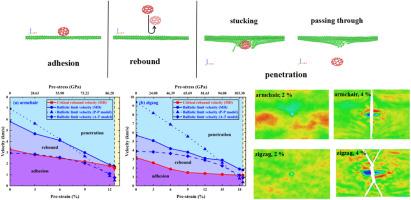Controllable dynamic mechanical behavior of graphene under impact through pre-strain/pre-stress: adhesion, rebound, and penetration
IF 11.6
2区 材料科学
Q1 CHEMISTRY, PHYSICAL
引用次数: 0
Abstract
Graphene exhibits distinguished impact resistance and specific energy dissipation, and has enormous application in the field of protective engineering. Herein, based on molecular dynamics simulation and theoretical models, we propose that pre-strain/pre-stress can dynamic control the dynamic mechanical behavior of graphene under the impact. Phase diagrams are presented to illustrate three typical responses: adhesion, rebound, and penetration. These responses rely on the pre-strain direction in the graphene noticeable. Both the critical rebound velocity and the ballistic limit velocity decrease significantly with the increasing pre-strain. The critical rebound velocity of the projectile can be adjusted about 36 % (60 %) under armchair (zigzag) direction tensile pre-strain, which means control the mutual conversion between adhesion and rebound behavior. The ballistic limit velocity of the graphene can be adjusted about 63 % (49 %) under armchair (zigzag) direction pre-strain, which means control the level of difficulty to break/perforate the graphene. The failure modes of graphene can be controlled by the pre-strain direction. In addition, the relations between the residual velocity of projectile and the pre-strain of graphene are revealed with different initial impact velocity of projectile. The specific energy dissipation is unveiled in phase diagrams with the variation of pre-strain in graphene. This work not only opens up frontiers for adjusting the impact behavior, but also provides a key theoretical basis for the optimization design of graphene in impact and protective engineering.

石墨烯在预应变/预应力冲击下的可控动态力学行为:粘附、回弹和渗透
石墨烯具有优异的抗冲击性能和比耗能性能,在防护工程领域有着广泛的应用。在此,基于分子动力学模拟和理论模型,我们提出预应变/预应力可以动态控制石墨烯在冲击下的动态力学行为。相图展示了三种典型的反应:粘附、回弹和穿透。这些响应依赖于石墨烯中可见的预应变方向。随着预应变的增大,临界回弹速度和弹道极限速度均显著降低。在扶手椅(之字形)方向拉伸预应变作用下,弹丸的临界回弹速度可调节36%(60%)左右,即控制弹丸黏附与回弹行为的相互转换。在扶手椅(之字形)方向预应变下,石墨烯的弹道极限速度可以调节63%(49%)左右,这意味着可以控制石墨烯断裂/穿孔的难度水平。石墨烯的破坏模式可以通过预应变方向来控制。此外,还揭示了不同初始冲击速度下,弹丸残余速度与石墨烯预应变之间的关系。在相图中揭示了比能耗散随石墨烯预应变变化的规律。这项工作不仅为调整冲击行为开辟了新领域,也为石墨烯在冲击与防护工程中的优化设计提供了关键的理论依据。
本文章由计算机程序翻译,如有差异,请以英文原文为准。
求助全文
约1分钟内获得全文
求助全文
来源期刊

Carbon
工程技术-材料科学:综合
CiteScore
20.80
自引率
7.30%
发文量
0
审稿时长
23 days
期刊介绍:
The journal Carbon is an international multidisciplinary forum for communicating scientific advances in the field of carbon materials. It reports new findings related to the formation, structure, properties, behaviors, and technological applications of carbons. Carbons are a broad class of ordered or disordered solid phases composed primarily of elemental carbon, including but not limited to carbon black, carbon fibers and filaments, carbon nanotubes, diamond and diamond-like carbon, fullerenes, glassy carbon, graphite, graphene, graphene-oxide, porous carbons, pyrolytic carbon, and other sp2 and non-sp2 hybridized carbon systems. Carbon is the companion title to the open access journal Carbon Trends. Relevant application areas for carbon materials include biology and medicine, catalysis, electronic, optoelectronic, spintronic, high-frequency, and photonic devices, energy storage and conversion systems, environmental applications and water treatment, smart materials and systems, and structural and thermal applications.
 求助内容:
求助内容: 应助结果提醒方式:
应助结果提醒方式:


